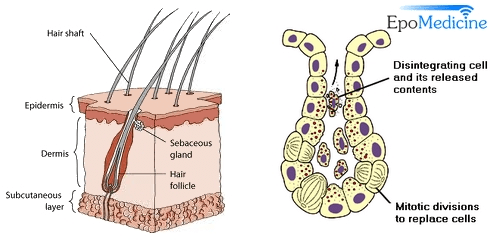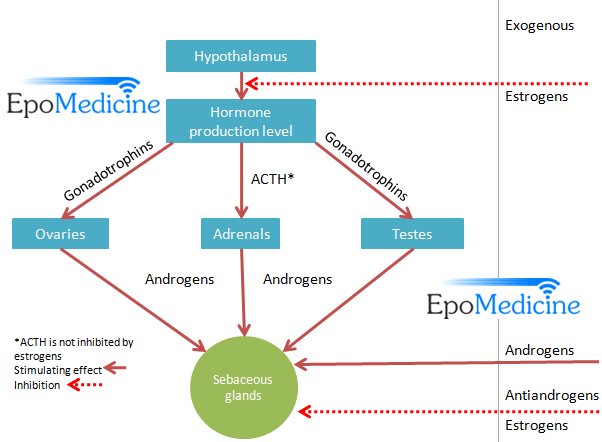Definition: Sebaceous glands are numerous microscopic glands in the dermis that usually open into the hair follicles and secrete sebum. They are holocrine glands, i.e., the sebum consists of the entire secreting cells.
Location: Found everywhere on the skin apart from the palms and soles
Types of Sebaceous glands:
1. Associated with hair follicles in hair covered areas:
- Numerous and prominent on the head, neck, chest and back
- These lie in the obtuse angle between the follicle and the epidermis
- Discharge their secretions into the ducts of hair follicles
2. Free/Modified sebaceous glands independent of hair follicles:
- Seen at sites devoid of hair (glaborous skin) – mucosal margins
- These open directly on the surface
- Found in:
- Eyelid (meibomian glands)
- Margins of lip (Fordyce spot)
- Areola of nipples (Montgomery tubercles)
- Prepuce of penis (Tyson glands)
- Mucocutaneous surface of female genitalia
- Peri-anal region
Histology of Sebaceous gland:
1. Multilobed gland: made up of lipid containing cells, which secrete sebum as a holocrine secretion
2. Duct: usually opens into hair follicles
Composition of sebum: triglycerides, fatty acids, wax esters, squalene and cholesterol
Note: Free fatty acids are produced by breakdown of triglycerides by lipases secreted by bacteria – Propionibacterium acnes
Functions of sebum:
- Lubricant for skin
- Mild bacteriocidal and fungistatic activity
- Vitamin D precursor and Vitamin E production
Variation in sebum secretion:
- Sebum secretion varies between body regions and individual to individual.
- Sebum output in descending order: scalp and forehead, face, back and chest, axilla, pubis, neck, abdomen, lower arm, leg, back of hand and ankle
Hormonal control of Sebaceous glands:
Androgenic hormones, especially dihydrotestosterone, stimulate sebaceous gland activity but it is not the level of circulating androgens which is important, but an enhanced end organ sensitivity. Human sebaceous glands contain 5α reductase, 3α- and 17α-hydroxysteroid dehydrogenase, which convert weaker androgens to dihydrotestosterone, which in turn binds to specific receptors (PPARs and Melanocortin receptors) in sebaceous glands, increasing sebum secretion.
At birth the sebaceous glands are functional, but after that they become less active until puberty.
Growth hormone and thyroid hormone also affects sebum production.
Disorders of Sebaceous gland:
- Acne
- Rosacea

